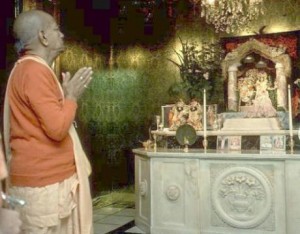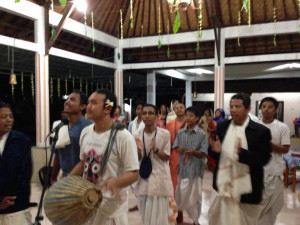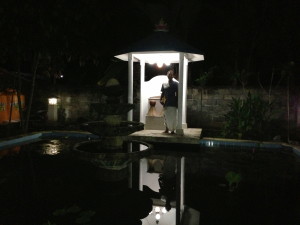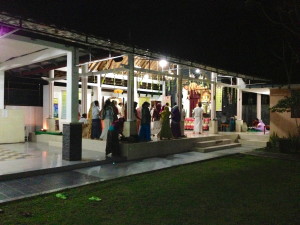Mahavishnu Swami Morning Class – Green Gathering Festival – 3 Aug 2013
Mahavishnu Swami Morning Class – Green Gathering Festival – 3 Aug 2013
Thursday, August 8th, 2013
→ The Walking Monk
Burnaby, British Columbia
I had begun and ended the day with chanting, walking by Riverside, established in 1861. The river being referred to is the Fraser, a major water artery in the lower mainland Vancouver.
Re-visiting the same route a second time felt like the day looped. I ended where I started. And that is pretty much how life is. It's cyclic. Such are the movements of the sun. The moon. The seasons go that way as well.
Our tiny spark of life, our very self, meets birth and death repeatedly until we make a change within. It's a circle game and then we make it linear. Apparently we will connect again with a world of circles.
The Sastras, ancient texts, reveal that we will be walking in a world free of inebriates.The walk, which will be under the shelter of either a fresh sun or a full moon, will have kick to it. It may be a skip, most definitely a dance.
I'm reminded that the current world in which we live in is a perverted reflection of the spiritual world. Our guru used to say this. We can ask ourself, "How can I get out of the perversities of life?" The answer would have some content to do with how you walk your way in this world. It would be good to take the steady march of dharma, of principles, while enjoying the stroll at the same time.
Out of a sense of duty, I found myself dealing with a number of practical issues involving the community. Some of the matter were quite draining but I pulled through and came to terms with sticking to duty. I felt some comfort in that resolve as well as some reciprocation from the Lord in the Heart.
I will try again, and again and try to loop it.
8 KM
Aug’ 8, ’13 Photos
→ Krishna Lounge
Raise The Bar
→ Japa Group

I had a dream last night...it was very clear. I was with my godbrothers and we were sitting in a circle talking about the importance of Japa. In the dream I spoke up and recalled what I had heard in a Japa retreat with Bhurijana dasa - he had said that we should raise our standard of chanting so that when we chant, we can remember that this is for the pleasure of Krsna and not just for our own purification.
Avidya is the foundation for ahankara
→ The Spiritual Scientist
Avidya, a misconception about one's spiritual identity, provides the foundation for ahankara, or false ego within the heart.
Radha Kunjabihari
→ Ramai Swami
Visiting the Radha Kunjabihari Mandira in Klung Kung is always a pleasure. This temple, which was designed by a local devotee architect, is very beautiful with an asrama, gardens, pond, kitchen and hall. The deity room and simhasam are made in an attractive Balinese style.
Giriraja Publishing releases Srila Jiva Gosvami’s Tattva-sandarbha
→ Jayadvaita Swami
Giriraja Publishing, part of the BBT publishing group, has released the translation and commentary on Srila Jiva Gosvami’s Tattva-sandarbha done by Gopiparanadhana Dasa. You can purchase it at blservices.com

The post Giriraja Publishing releases Srila Jiva Gosvami’s Tattva-sandarbha appeared first on Jayadvaita Swami.
The Perfection of Life
→ travelingmonk.com
84 pics: Preaching and chanting on a Russian boat with Bhakti Vijnana Goswami, August 3
→ Dandavats.com
 84 pics: Preaching and chanting on a Russian boat with Bhakti Vijnana Goswami, August 3, 2013 Read more ›
84 pics: Preaching and chanting on a Russian boat with Bhakti Vijnana Goswami, August 3, 2013 Read more › Inconceivable
→ travelingmonk.com
How do we ensure that we don’t just enjoy KC intellectually and not advance spiritually?
→ The Spiritual Scientist
From Shyam P
Why is the Bhagavad-gita so important among the Vedic texts?
→ The Spiritual Scientist
Why is the Vedic Sanskrit and Puranic Sanskrit different?
→ The Spiritual Scientist
From Shyam P
15 pics: Distribution of BBT Books in the United States of America
→ Dandavats.com
 15 pics: Distribution of BBT Books in the United States of America Read more ›
15 pics: Distribution of BBT Books in the United States of America Read more › 48 min vid: The Boy Who Lived Before
→ Dandavats.com
 Cameron, ever since he was just a toddler, talks about another family he used to live with. He knows the names of his previous family, where they lived, and can even describe the house and the landscape of his previous home on the island of Barra, some 200 miles away. Read more ›
Cameron, ever since he was just a toddler, talks about another family he used to live with. He knows the names of his previous family, where they lived, and can even describe the house and the landscape of his previous home on the island of Barra, some 200 miles away. Read more › The Huffington Post: Why this devotee of God doesn’t think atheists are demonic?
→ Dandavats.com
 In the Bhagavad-gita Krishna lists six qualities -- pride, arrogance, conceit, anger, harshness and ignorance -- which mark the demoniac nature." Read more ›
In the Bhagavad-gita Krishna lists six qualities -- pride, arrogance, conceit, anger, harshness and ignorance -- which mark the demoniac nature." Read more › Gaura-priya asks about chronology in the Bhagavatam and the presence of demons in Goloka
→ SivaramaSwami.com
Conversation.
Who doesn’t want to see 121 more pics of the glorious Los Angeles Ratha Yatra 2013
→ Dandavats.com
 121 pics: Los Angeles Ratha Yatra 2013 Read more ›
121 pics: Los Angeles Ratha Yatra 2013 Read more › What is the Festival of the Chariots?
→ HH Bhakti Caitanya Swami
August 10th, 2013 – Darshan
→ Mayapur.com
The post August 10th, 2013 – Darshan appeared first on Mayapur.com.
57 pics: Iskcon Hare Krishna Land Guyana
→ Dandavats.com
 57 pics: Iskcon Hare Krishna Land Guyana Read more ›
57 pics: Iskcon Hare Krishna Land Guyana Read more › Hari Sauri Recalls Srila Prabhupada Reuniting with Kaliya, New Vrindaban’s First Cow – June 28th, 1976
→ New Vrindaban Brijabasi Spirit
Hari Sauri Recalls Srila Prabhupada Reuniting with Kaliya, New Vrindaban’s First Cow.
Hari Sauri’s diary: New Vrindaban, West Virginia 06-28-1976
This morning Kirtanananda Maharaja arrived in his pickup to drive Srila Prabhupada up to the original New Vrindaban farm where the community first started. Srila Prabhupada sat in the cab while devotees scrambled up into the back or ran up the trail after it. It was a long and bumpy drive up the dirt road, and afterward Srila Prabhupada complained about heart strain.
He had Kirtanananda stop some distance from the house and walked the rest of the way, accompanied by twenty or thirty devotees. The sun was just rising over the distant hills, its rays gently diffusing through the light morning mist. Prabhupada walked steadily up the track, preceeded by one of New Vrindaban’s four-legged residents, a large black cow.
At the house the rest of the devotees, including the gurukula children, lined up along the pathway to greet him. Prabhupada looked obviously content to return to the original house in which he had stayed in 1969 when he first came to New Vrindaban. Now it serves as the brahmacari asrama and the residence of the beautiful brass forms of Sri Sri Radha-Vrndavananatha. After his darsana of the Deities, Prabhupada gave class there at the house on Srimad-Bhagavatam 7.6.14.

Srila Prabhupada takes darshan of Sri Radha Vrindabannatha at the original New Vrindaban farmhouse, 1976.
His talk lasted only about fifteen minutes. The verse described how a man who is too attached to family life cannot understand that by such activities he is wasting his time. Indeed, he does not develop a distaste for material existence even though he undergoes three kinds of suffering.
Srila Prabhupada explained there are two classes of men, the bhogi, who is always trying to enjoy his mind and senses, and the yogi, who tries to give up his entanglement. Among the yogis, that person who engages in devotional service to Krsna is the best. He said that by yoga, one achieves siddhi, perfection.
As an example of yogic siddhi he cited something he had heard in his school days. “In my childhood there was my teacher. He said that he had his guru, a yogi. So he told me that his spiritual master, yogi, he inquired from his disciple, ‘What do you want to eat?’ So he said that ‘We want to eat some pomegranate from Kabul.’ So he said, ‘Yes, you can get it. Go into the room and you’ll find.’ So they found a bunch of pomegranate just fresh taken from the tree. This is called prapti-siddhi.” Of course, he told us, this kind of siddhi is material. It is not for the devotee, who alone can attain perfect satisfaction by surrender to Krsna.
At the conclusion of class Srila Prabhupada returned in the truck to the house for breakfast and a short rest.
Material Resources for Spiritual People
→ Dandavats.com
 The devotees of Ramana Reti have done this nice site and facebook group and may be it coud be helpful to do for our other large Iskcon communities too Read more ›
The devotees of Ramana Reti have done this nice site and facebook group and may be it coud be helpful to do for our other large Iskcon communities too Read more › 20130805 HG Gaura Krishna das – Lessons from Pencil maker.
→ Gouranga TV - The Hare Krishna video collection
20130805 HG Gaura Krishna das – Lessons from Pencil maker.
03.39 – When a wildfire appears to be the cure for a burn, a wildfire is burning our head
→ The Spiritual Scientist
When a fire burns us, we immediately move away from it towards something cooling and healing.
Yet when the fire of lust burns us, we imagine that moving closer to that fire will cool and heal us.
That’s how lust covers and perverts our intelligence. The Bhagavad-gita (03.39) indicates that lust is like a fire that is insatiable (dushpurenanalena). Further, it obstructs and obscures our knowledge (avritam jnanam), leaving us to fend for ourselves in ignorance and illusion. And the way we fend for ourselves is by exposing ourselves more to the stimuli that provoked the lust within us, hoping to get relief.
If we get to indulge in lust, we do get some momentary relief, relief that we mistake to be life’s greatest pleasure. But soon the relief ends and the burning desire re-appears. And it comes back, bigger and wilder, scalding us with worse burns of craving that demand relief through more depraved forms of indulgence. Seeking relief from those burns, we rush into a wildfire of sensuality and debauchery. Thus lust keeps burning and tormenting us lifetime after lifetime, as the Gita’s sobering declaration of it as “eternal enemy” (nitya-vairi) underscores.
The only way out of this trap is through intelligence and grace.
When the burn of lusty craving starts tormenting our heart and we feel that the wildfire of immoral sexual indulgence will remove that torment, we need to use our intelligence to recognize that the wildfire of lust has started burning up our knowledge internally. If we seek the grace of Krishna by calling out his holy names, then his soothing remembrance will extinguish the fire of lusty desire and show us the way to lasting relief in his eternal love.
***
Thus the wise living entity’s pure consciousness becomes covered by his eternal enemy in the form of lust, which is never satisfied and which burns like fire.
Book distribution technique
→ KKS Blog
(Kadamba Kanana Swami, 25 April 2013, Radhadesh, Belgium)
 I remember, we had a book distribution technique where first we used to stand out in the rain, here in Barvaux and we used to knock on the windows of cars and then try and sell books. Then someone changed the technique and when it rained, we stayed in the car, we wound down our window, and we called people over as if we were lost, and it worked very well. At least we stayed dry and they got wet!
I remember, we had a book distribution technique where first we used to stand out in the rain, here in Barvaux and we used to knock on the windows of cars and then try and sell books. Then someone changed the technique and when it rained, we stayed in the car, we wound down our window, and we called people over as if we were lost, and it worked very well. At least we stayed dry and they got wet!
False shelters perpetuate the struggle for material existence
→ The Spiritual Scientist
This world of maya is called durasraya, which means "false or bad shelter." One who puts his faith in durasraya becomes a candidate for hoping against hope. In the material world everyone is trying to become happy, and although their material attempts are baffled in every way, due to their nescience they cannot understand their mistakes. People try to rectify one mistake by making another mistake. This is the way of the struggle for existence in the material world.
Enter The Kṛṣṇa Planet
→ Japa Group

So if one quits his body at the end of life chanting Hare Kṛṣṇa, Hare Kṛṣṇa, Kṛṣṇa Kṛṣṇa, Hare Hare/ Hare Rāma, Hare Rāma, Rāma Rāma, Hare Hare, he certainly reaches one of the spiritual planets, according to the mode of his practice. The devotees of Kṛṣṇa enter the Kṛṣṇa planet, Goloka Vṛndāvana.
Bhagavad-gītā As It Is 8.13
Leaf Picking
→ MukundaGoswami.org
Leaf Picking
→ MukundaGoswami.org
Krsna Creates by Thinking
→ MukundaGoswami.org
In Rainfall
→ MukundaGoswami.org
Noises
→ MukundaGoswami.org
Vegetarianism
→ MukundaGoswami.org
Ghouls
→ MukundaGoswami.org
the mighty trio
→ everyday gita
Attachment, fear and anger - or as I call them - the mighty trio. These three emotions and characteristics have the capacity to steal away all reason and intelligence. In fact, as readers might remember, two of these three characteristics (attachment and anger) are also members of "the attachment trap".
It's not so much that these qualities or emotions are good or bad in and of themselves. It's the fact that one emotion leads to another which can ultimately lead to stress and complete frustration.
The cycle tends to go as such:
As was previous explained, attachment arises due to the contemplation of objects which we believe will satisfy and make us happy. Once attachment takes root, that's when the chaos can start to manifest. Take for example a small child. They might be perfectly happy playing in their corner when they see a ball across the room. Looking at the ball, they start to make their way towards it when another child picks it up. At this point in time, some children, may start to cry and get upset.
This is actually very illustrative of what we all go through if we just seek to look a little deeper and analyze what is motivating the child's behaviour. Many might think the child is crying because they didn't get to play with the ball, but one could suggest that it's even more than that. It's the fact that the other child got to play with it.
That's where fear and anger step in because...
Attachment often instills a sense of possessiveness in an individual.
In other words, it's the mentality of "I've contemplated the object and therefore it is mine." What the bhakti texts teach us is that the moment we identify ourselves with something then fear is often a side dish that comes along, even though we haven't asked for it. We fear losing whatever we've become attached to and if anything appears to impede our enjoyment of that object then anger rears its ugly head.
The path of bhakti yoga reminds us that nothing in this world is ours to keep. This body and the world we live in is all on loan. Trying to exert ownership and control doesn't really help us.
For those who truly want to practice yoga, this is such an integral point. Yoga is about connection but almost more important than understanding that fundamental truth is understanding what it is that we should be trying to connect to.
Attachment is just one facet of connection but it's not the whole thing.
An attachment can be broken, but a connection, as per the definition of yoga, is rooted in permanency. That permanent connection that all souls are longing for is eternal love and the only person who can give it to us is the Divine. All of these other objects that we form attachments to can get in the way of our search for that love if we aren't careful.
So the next time you catch yourself falling into this trap of this mighty trio, take a step back and observe. Is this attachment helping you to become a selfless, compassionate and positive individual or is it serving to bring out the opposite in you?
Food for All Plymouth Rathayatra with the Gurukulis
→ simple thoughts
Dear Maharajs/Prabhus,
pamho agtsp,
Plymouth Rathayatra July 2013
In 1620 the Mayflower left Plymouth on a pilgrimage to the new lands in America.
Plymouth is also the starting point of the massive UK slave industry.
But this time Plymouth becomes a pilgrimage place due to Jagannath’s presents and pure devotional service has replaced slavery.
Manu prabhu organised a pilgrimage from America of 40 enthusiastic “gurukuli kids”, and boy can they chant the Holy Name.
Such wonderful devotees gives us hope in the future of Harinam.
your servant Parasuram Das
Enjoy the movie
94 pics: Scenes from the Los Angeles Rathayatra, August 4th, 2013
→ Dandavats.com
42 min vid: Jesus in India? – A BBC Documentary
→ Dandavats.com
63 pics: Hariyali Teej @ Iskcon Vrindavan 9/8/2013
→ Dandavats.com
 In the ISKCON Krishna-Balaram Temple at Vrindavan, the sanctum sanctorum of the Deities are beautifully decorated with green bush leaves and blossoming flowers for Them to feel pleasure-roam in the lush green forests of Vrindavan Read more ›
In the ISKCON Krishna-Balaram Temple at Vrindavan, the sanctum sanctorum of the Deities are beautifully decorated with green bush leaves and blossoming flowers for Them to feel pleasure-roam in the lush green forests of Vrindavan Read more › 









